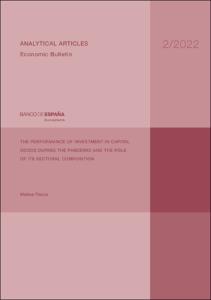Registro completo de metadatos
| Campo DC | Valor |
|---|---|
| dc.contributor.author | Pacce, Matías |
| dc.coverage.spatial | España |
| dc.date.accessioned | 2022-04-21T19:02:38Z |
| dc.date.available | 2022-04-21T19:02:38Z |
| dc.date.issued | 2022-04-21 |
| dc.identifier.uri | https://repositorio.bde.es/handle/123456789/20942 |
| dc.description | Artículo de revista |
| dc.description.abstract | The COVID-19 crisis has had a very uneven impact on the different productive sectors of the economy, with those requiring less personal contact or that are less labour-intensive, such as industry, being the least affected. This appears to have been a determining factor behind the buoyancy observed in investment in capital goods during the current crisis, as the sectors representing a higher relative share of investment are those that, broadly speaking, have been more resilient. The drive towards digitalisation and e-commerce has also helped cushion the fall in this aggregate in the current crisis, as they require investing in the relevant equipment. Furthermore, unlike in previous recessions, the relatively favourable financing conditions have helped prevent this factor from being an additional constraint in tackling planned investment projects. Lastly, general government has also played a key role in sustaining investment in capital goods during this crisis, given the effort required in terms of digitalisation in order to continue providing services in a setting marked by mobility restrictions and the need to acquire equipment to deal with the health emergency. |
| dc.format.extent | 14 p. |
| dc.language.iso | en |
| dc.publisher | Banco de España |
| dc.relation.ispartof | Economic Bulletin / Banco de España, 2/2022 |
| dc.relation.hasversion | Versión en español 123456789/20922 |
| dc.rights | Reconocimiento-NoComercial-CompartirIgual 4.0 Internacional (CC BY-NC-SA 4.0) |
| dc.rights | In Copyright - Non Commercial Use Permitted |
| dc.rights.uri | https://creativecommons.org/licenses/by-nc-sa/4.0/deed.es_ES |
| dc.rights.uri | http://rightsstatements.org/vocab/InC-NC/1.0/ |
| dc.subject | Investment |
| dc.subject | Capital goods |
| dc.subject | Economic cycles |
| dc.subject | Structural analysis |
| dc.subject | Economic situation |
| dc.title | The performance of investment in capital goods during the pandemic and the role of its sectoral composition |
| dc.type | Artículo |
| dc.identifier.bdebib | 000472750 |
| dc.identifier.bdepub | ECBU-2022-2B-art08 |
| dc.subject.bde | Fluctuaciones y ciclos económicos |
| dc.subject.bde | Presupuesto y contabilidad pública |
| dc.subject.bde | Renta, empleo y precios |
| dc.subject.bde | Política fiscal |
| dc.publisher.bde | Madrid : Banco de España, 2022 |
| dc.subject.jel | E22 |
| dc.subject.jel | E32 |
| dc.subject.jel | E62 |
| dc.subject.jel | H54 |












